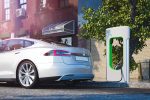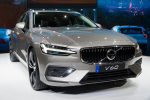Electric cars and how they fit into real life
It’s easy to still think of electric cars as a future-facing idea. The kind of thing that will be standard in ten years but still feels like a leap right now. That might have been true once, but things have moved on- electric cars are no longer just a cleaner option for drivers who want to make a difference. They work for regular day-to-day use, school runs, longer drives and quick errands in between. What used to feel like a compromise has evolved into something much more practical. However, for anyone wondering whether now is the right time to switch, the answer depends less on the technology and more on how you use your car. In most cases, the gap between electric and petrol is far narrower than it used to be- some would say it’s already closed.
Short trips suit electric cars well
Most daily driving in the UK involves short journeys. Supermarket runs, picking up from school, commuting into town or visiting friends nearby. This is where electric cars tend to shine. No engine to warm up, instant acceleration, and no petrol stations unless absolutely necessary. The range on most models easily covers this kind of usage for several days between charges. Some drivers have even found that a smaller range model works better than expected. Being able to plug in at home and top up overnight means there’s rarely any need to go out of the way to find a charger. The same goes for workplace charging. Even a few hours plugged in during the day can make a noticeable difference.

Longer drives are easier than before
The idea that electric cars can’t cope with motorways is out of date now. Most newer models have improved range, and the charging infrastructure has come a long way. Charging stops on longer journeys used to be slow and awkward, especially if there were only one or two working units. Now there are more options at motorway services and roadside locations, and most rapid chargers deliver enough charge in 20 to 30 minutes to carry on. Planning ahead helps. Apps make it easier to check availability in real time, and some systems now allow pre-booking. In a lot of cases, electric cars can be worked into longer trips with only small changes to the usual route. Families using them for school holidays, weekends away or trips to see relatives are finding that with a little preparation, the experience is no more stressful than a traditional road trip.
Cold weather is less of a problem now
Winter driving used to be a weak spot for electric cars. Range would drop suddenly, and charging could be slower than expected. That still happens to some degree, but it is far more predictable now. Batteries are better managed, preconditioning is easier to set up, and cabin heating systems are more efficient. These small improvements make a real difference to everyday use. Even things like window defrosting and seat warmers now draw less energy than before.
Charging habits are becoming more flexible
People often ask how often an electric car needs charging. The answer is usually somewhere between twice a week and once every few days, depending on the car and the driver. For those with access to home charging, plugging in is as routine as putting the kettle on- it becomes part of the background of the week, rather than a task that takes effort.
Public charging is improving bit by bit with rapid chargers being quicker, more widespread and more reliable than they were even a year ago.
Contactless payment is common now, and many chargers work with simple plug-and-go systems. It is not perfect everywhere, but it is no longer something that only works in major cities or retail parks. Some drivers also mix in occasional workplace or destination charging. Plugging in at the gym, while shopping or at a hotel makes sense and is becoming more common. These smaller top ups reduce the pressure to fully charge every time and suit people with less predictable schedules. With more people installing chargers at home and businesses investing in better infrastructure, it’s also become more important to choose a reliable electrical cable supplier to make sure charging systems stay safe and efficient long term.
Servicing and running costs are lower than many expect
Once on the road, electric cars are generally cheaper to run. There are fewer moving parts to maintain, no oil to change and less strain on components like brakes. Most drivers notice a drop in regular maintenance costs and fewer unexpected repairs. The other ongoing cost is charging. For those on the right tariff, charging at home works out far cheaper than petrol. Even public charging, while sometimes more expensive, still compares favourably to filling up at the pump. When energy costs spiked, that gap narrowed, but it has widened again now that prices have stabilised. Insurance is still a mixed picture. Some electric cars are cheaper to insure, especially with specific providers who understand the technology. Others are more expensive because of higher upfront value or specialist parts. It depends on the model, but the market is adapting.

![[AD] We’re a cricket-mad family, so we’re buzzing that @thehundred is back this August! 🏏🔥
To get ready, M tried out the official FREE Activity Pack — and it’s brilliant! 🙌
Packed with fun games, creative challenges and sporty tasks, it’s perfect for getting kids hyped whether you’re at home or on the go.
👉Download yours now (link in bio)
@londonspirit @ovalinvincibles #EveryMomentCounts #TheHundred
#EnglandCricket #CricketFamily #TheHundredCricket #LondonBloggers #Cricket #CricketIsLife #kidsfun](https://suburban-mum.com/wp-content/uploads/2022/11/505472555_18531279601016840_7092520074819907569_n-180x320.jpg)



![[AD - Press visit]
We enjoyed the glorious sunshine this weekend with a trip to Brighton. We went on the @brightoni360official which is right by the sea front.
The i360 pod take a slow journey up, allowing you to take in views across Brighton and the South Downs 450ft above ground. There’s a bar inside with drinks and snacks available to purchase and the experience lasts 25 minutes.
Afterwards, we headed to the open air roller rink for a roller skating session!
The roller rink is:
⭐ Suitable for over 5s
⭐ £6.50 if you have your own skates or £9.50 if you need to hire them
⭐ 45 minutes per session
Full details to visit the i360 + skating
📍 Brighton i360, Lower Kings Road, Brighton BN1 2LN
🚗 Parking nearby (we parked in the Regency Square Car park)
🎟️ Prices start from £25.40 for an adult and £16.90 for a child
🕐 Opening hours are currently Sun-Fri 10.30am-18.30pm and until 19.30pm on Saturdays
☕️ Bar inside the i360, cafe and gift shop
Book tickets here:
https://tickets.brightoni360.co.uk/tickets/?_ga=2.195305772.1869001490.1689671753-1757164059.1689671753/#events?eventid=157](https://suburban-mum.com/wp-content/uploads/2015/04/417980235_313576471048632_3682382982231216432_n.jpg)

![[AD] ***Summer of fun at Barracudas Activity Camps!****
There is plenty for kids to do at @barracudas_activity_day_camps
From Tennis, Archery, Swimming, Motor Sports and more you can be sure that there will be something for kids aged 4.5-14. ⚽🏈🥅🎾🏓🏎️🏹🏊♂️🏉
You can book on a day by day basis - so it can fit in with any other days out/activities you have planned and there are early drop off and late pickup options available. Barracudas are also Ofsted registered so you can use your Childcare Vouchers too.
⭐⭐⭐Get £20 off a week or £4 off a day using my discount code: MARIA20⭐⭐⭐
#BarracudasActivityDayCamp #BarracudasActivityCamp #BarracudaAmbassadors #SummerHolidays #SchoolHolidays #Summer2023 #SummerCamp #DayCare #Camp #KidsCamp #surreymummy #surreymums #SummerOfFun #ActivityCamps #HolidayCamps #Childcare #SchoolHolidays #schoolholidaycamps](https://suburban-mum.com/wp-content/uploads/2024/07/353583570_625625966167953_545896259645102575_n.jpg)



![[AD] We have some super exciting news...we have been chosen to be Laser Quest Ambassadors, and the boys are over the moon!
We are really lucky that our local Laser Quest (@laserquestkingston) is just around the corner from us. It means we can pop in of a weekend or anytime during the school holidays, and with summer just around the corner, I know Laser Quest will be one of our go-to places for some family fun.
As well as games of Laser Quest, there are also VR experiences and arcade amusements too. To find out a bit more about how Laser Quest works, you can read my blog post: https://www.suburban-mum.com/laser-quest-kingston/ (clickable link in bio)
Don't forget to keep an eye out for our Laser Quest posts - I'm going to be giving away two family passes to use at Laserquest Kingston!
If you can't wait and want to head down to Laser Quest to try it out, use the code SUMMER30 for 30% off your booking. The code is valid from now until the end of August 2023 and can be used on Laser Quest games and birthday party bookings.
#LaserquestAmbassador #Laserquest #LaserquestKingston #ActivitiesForKids #FamilyFun #DaysOutWithKids #Lasertag #LaserquestVR #Kingston #ThingsToDoInKingston #SurreyFamilyDaysOut #ThingsToDoWithKids #RainyDayFun #SurreyMummy #SurreyLife #LifeWithKids #LifeWithBoys #familyfunday](https://suburban-mum.com/wp-content/uploads/2015/04/353230107_797358078406942_2405522556733455165_n.jpg)

![[AD] The sun has finally made an appearance and the boys have been making the most of it by spending it
in the garden.
They’re go-to is always football and they’ve been trying to improve their aim and accuracy with the new Messi Foldable Footlball goal from the #MessiTrainingSystem range.
I love the fact the goal is foldable, making it easy to store away when not in use. It is also lightweight so you can effortlessly pack it up and take it to the park or to a friend’s house.
The Messi Foldable Football Goal retails at £36 and can be purchased from @argos
You can read my full review here: https://www.suburban-mum.com/messi-foldable-football-goal/
#TrainLikeMessi #FoldableFootballGoal #FootballSkills #OutdoorFun #LionelMessi #LeoMessi #FootballAtHome #OutdoorKids #JustGetOutside #OutdoorsAndFree #ScreenFreeKids #WhateverTheWeatherKids @flair_gp](https://suburban-mum.com/wp-content/uploads/2015/04/341194882_615024710178056_41977149395989448_n.jpg)

![[AD] We are absolutely thrilled to announce that we are Barracuda Ambassadors again this year.
With Easter just around the corner, the boys were sent the @barracudas_activity_day_camps new camp kit in preparation for the school holidays.
There’s a wide range of activities for kids aged 4.5 - 14 including Tennis, Archery, Basketball, Arts & Crafts and more.
If you like the sound of Barracudas, find out more over on their website. You can also save £20 a week or £4 a day, using my discount code: MARIA20](https://suburban-mum.com/wp-content/uploads/2024/07/336812306_765234558514317_685553691647241974_n.jpg)


![[AD - Gifted]
Last weekend we were invited to try out @tsarettaspice’s new Bottomless Brunch menu and I can tell you it was thumbs up all round!
There’s a good choice tapas on offer from Punjabi fish fingers, Indo Chinese Chicken to Spiced Lamb Scotch Eggs and Manchurian Cauliflower (which was amazing!)
If you’re local to Twickenham and fancy giving them a try here’s are the details.
Tsaretta Spice Bottomless Brunch
⭐️£37.50 per head for bottomless Prosecco or cocktail of the day
⭐️£55 per head for bottomless Champagne
⭐️ Food included: 4 tapas selections and dessert or 2 tapas selections, a pav or naanwich and dessert
⭐️ Non-alcohol brunch is also available
Tsaretta Spice
55 Church Street
Twickenham
TW1 3NR
You can also read our full review over on the blog (link in bio)](https://suburban-mum.com/wp-content/uploads/2024/07/334565436_5960402314015030_663031098700829518_n.jpg)
![[AD] What does family look like for you?
I am fortunate to be surrounded by strong, powerful women in the form of my mum, sister and mother-in-law (along with many others). With Mother’s Day just around the corner, @BootsUK want to celebrate all the different mums and mother figures we are lucky enough to have in our lives. They have a huge range of Mother’s Day gifts to choose from so we can show them how much they mean to us. (swipe to take a look at some of my choices)
If you want to express love and appreciation for the mother figure(s) in your life, head to Boots.com to find the ideal gift. They have a whole host of gifts, so you can be sure to find something to suit all tastes. Celebrate the #LoveForAllMums this Mother’s Day with Boots.
](https://suburban-mum.com/wp-content/uploads/2015/04/334276459_136658625736352_6403224988403337253_n.jpg)



